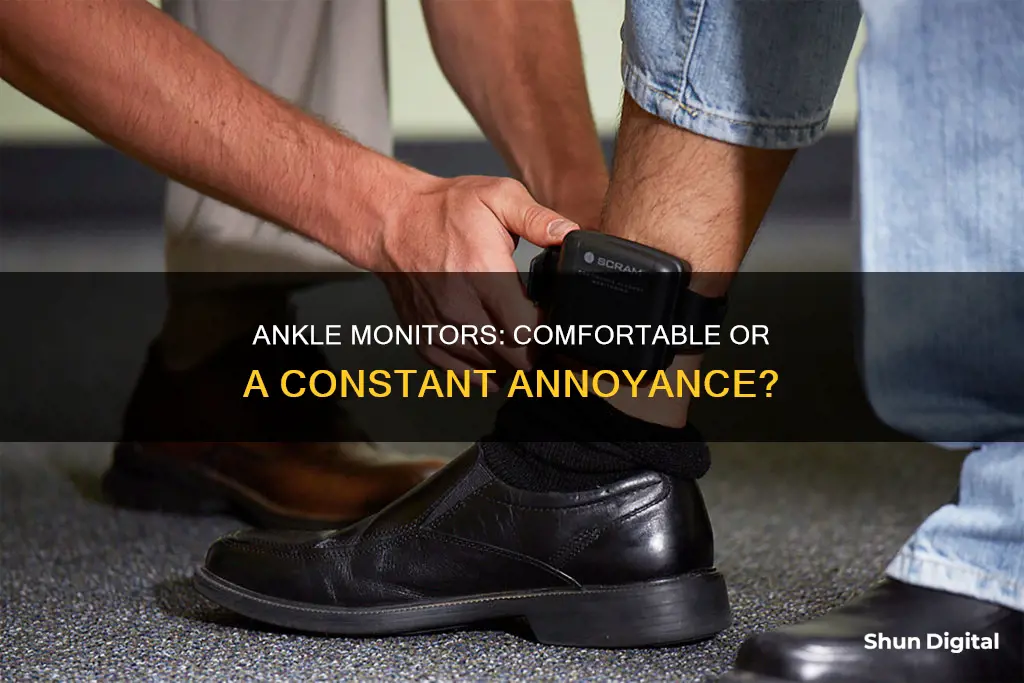
Ankle monitors, used as an alternative to incarceration, are devices that track the location of individuals to ensure they comply with the terms of their release. While they are intended to offer freedom to the wearer, they can be uncomfortable and restrictive. The devices are typically bulky and difficult to conceal, often causing embarrassment and stigmatisation. They can also be heavy and painful, leading to physical ailments such as lower back problems, foot numbness, scarring, and bleeding. The monitors must be regularly charged, which can be inconvenient and time-consuming, and the associated costs can be a financial burden, pushing some into debt. Overall, while ankle monitors offer an alternative to incarceration, they can impose their own form of imprisonment through physical discomfort, social stigma, and financial strain.
| Characteristics | Values |
|---|---|
| Size | Baseball-sized |
| Ease of concealment | Difficult to conceal |
| Design | No significant changes in 30 years |
| Appearance | Bulky |
| Weight | Becomes heavier throughout the day |
| Comfort | Uncomfortable |
| Health effects | Lower back problems, foot numbness, scarring, bleeding, skin irritation, impaired circulation, electric shocks, hair loss, headaches, difficulty breathing |
| Charging | Requires charging twice a day for two hours |
| Cost | Set-up fee between $175 and $200; daily fee ranges from $5 to $40 |
| Privacy | Makes criminal record freely available to anyone who notices them |
What You'll Learn

Ankle monitors are stigmatising
The design of ankle monitors has not changed significantly in 30 years, suggesting that the stigma of wearing them and the difficulty of hiding them could be intended as part of the punishment. This is supported by the fact that other wearable technology, such as the Apple Watch or Fitbit, has been designed to be less conspicuous, smaller, and sleeker.
The monitors make the wearer's criminal record freely available to anyone who notices them, compromising privacy and jeopardising opportunities to form social bonds and obtain or maintain employment. This is especially true as the monitors are often highly visible, opening up wearers to discrimination by employers, law enforcement, and members of the public.
The stigmatising nature of ankle monitors is further evidenced by the fact that they are linked to a long history of shaming people, such as the metal masks medieval women convicted of being "nags" were forced to wear and the yellow armbands employed by the Nazis.
In addition to the social stigma, ankle monitors also create financial burdens for those who wear them. The set-up fees and daily charges for ankle monitors can be exorbitant, especially for indigent parolees, pushing people further into debt and creating a cycle of poverty.
Overall, the design, visibility, and financial costs of ankle monitors contribute to their stigmatising nature, making it difficult for wearers to reintegrate into their communities and move forward with their lives.
LCD vs LED Monitors: What's the Difference?
You may want to see also

They can cause physical harm
Ankle monitors can cause physical harm to the wearer in several ways. Firstly, they are bulky and difficult to conceal, which can lead to social stigma and psychological harm. The constant worry of being judged and assumed to be a dangerous criminal can take a toll on the wearer's mental health. The weight and tightness of the monitor can also cause lower back problems, foot numbness, scarring, and bleeding. The device needs to be charged regularly, and during this time, it can heat up, causing skin irritation.
Additionally, the design of ankle monitors has not changed significantly in decades, indicating that the stigma and difficulty of hiding them may be intentional parts of the punishment. The monitors are highly visible, which can lead to discrimination by employers, law enforcement, and the public. This visibility can also compromise privacy, as personal information such as location and conversations can be easily accessed and shared without the wearer's consent.
The monitors have also been known to give off false alerts, causing constant stress and worry for the wearer, who is at risk of being sent back to jail due to technical errors. Furthermore, the cost of renting and maintaining these devices can be exorbitant, leading to financial strain and even homelessness for some individuals.
In conclusion, while ankle monitors are intended as an alternative to incarceration, they can cause various types of physical harm, including medical complications, psychological distress, financial burden, and social stigma. These issues highlight the need for a holistic re-evaluation of the criminal justice system's reliance on electronic monitoring as a form of punishment and surveillance.
Eliminating Grid Alignment from Your Desktop Monitor
You may want to see also

They restrict liberty
Ankle monitors are a form of surveillance that can significantly restrict the liberty of those who wear them. The monitors are usually worn as an alternative to incarceration, but they can impose their own brand of imprisonment on the wearer. The devices are bulky and difficult to conceal, making it hard for the wearer to hide the fact that they have had a run-in with the law. This can lead to stigmatisation and humiliation, as people assume the wearer is a dangerous criminal. As a result, some choose to remain indoors rather than face public judgment.
The monitors can also restrict the wearer's movements. They are often used to enforce house arrest or to keep people within a certain radius. This can prevent people from attending social events, such as birthday celebrations or family get-togethers, or from travelling to other places, such as going on vacation. In addition, the monitors must be charged regularly, which can be inconvenient and time-consuming. The charging process can take up to two hours, during which the wearer must remain close to a power outlet.
Ankle monitors can also create financial burdens, with set-up fees and daily charges that can put people into debt. This can be especially difficult for indigent parolees, who may already be struggling financially. In some cases, the cost of the monitor is covered by the county, but often the wearer is responsible for the fees. This can lead to a cycle of poverty and unemployment, as employers may be reluctant to hire someone wearing an ankle monitor.
Furthermore, ankle monitors can have negative effects on the wearer's physical health, causing lower back problems, foot numbness, scarring, and bleeding. The devices can also be uncomfortable and irritating, with the constant weight on the ankle causing pain and impairing circulation. In some cases, they may even cause more serious medical complications, such as electric shocks, hair loss, headaches, and difficulty breathing.
Overall, while ankle monitors may be presented as an alternative to incarceration, they can impose significant restrictions on the liberty, finances, and well-being of those who wear them.
Locating Service Tag Numbers: A Monitor Troubleshooting Guide
You may want to see also

They can be expensive
Ankle monitors can be expensive, with fees for wearing them ranging from $3 to $35 a day, in addition to initial set-up charges of $100 to $200. These costs can amount to hundreds of dollars per month, overburdening households, especially those with loved ones returning from incarceration.
In at least 30 states, agencies require those placed on electronic monitors to pay between $2 and $20 per day to wear one, not including activation fees that some counties add on. In Baltimore County, Maryland, the monthly fees for ankle monitors became such a burden that the county moved to eliminate them altogether.
In Kentucky, if you are three days late with a payment, authorities can send you back to prison. In Iowa, if you lose or damage the tracking component of the device, you'll pay $795 to replace it; a missing power cord will set you back $55.
The high cost of ankle monitors can create a cycle of poverty and debt, as parolees struggle to pay for their daily use. In South Carolina, most parolees wearing ankle monitors can't pay the fees, so less than 1% of the fees are actually gained by the state. This means South Carolina taxpayers pick up a $3.5 million tab from uncollected fees. In Wisconsin, less than half of ankle monitor fees were collected in 2015, and only around 30% were collected in 2012-2014.
The cost of ankle monitors can also lead to difficult choices, with some people in the system having to choose between paying rent or monitor fees.
Identifying G-Sync in Monitors: A Quick Guide to Look For
You may want to see also

They may cause psychological harm
Ankle monitors can cause psychological harm to those who wear them. The monitors are bulky and difficult to conceal, displaying the wearer's involvement with the justice system. This can lead to stigmatization and prejudice, as people often presume that those wearing ankle monitors are dangerous criminals. The devices make it hard for wearers to form strong social bonds within their communities and may jeopardize their employment prospects.
The financial burden of paying for an ankle monitor can also take a psychological toll. The daily fees for wearing an ankle monitor can be exorbitant, especially for indigent parolees, pushing them further into debt. This financial strain can affect the wearer's spouse and family as well.
Ankle monitors also impose restrictions on the wearer's daily life and limit their freedom of movement. They must be charged regularly, which can be inconvenient and embarrassing in public places. The fear of violating the terms of their parole and the constant surveillance can take a mental toll on the wearer.
Additionally, the design of ankle monitors has not significantly changed in 30 years, suggesting that the stigma and difficulty of hiding them may be intended as part of the punishment. The bulkiness and visibility of the devices can contribute to the psychological distress of the wearer, reminding them constantly of their past mistakes and restricting their ability to move on with their lives.
Finding the Right External Monitor for Your Setup
You may want to see also
Frequently asked questions
Yes, they are uncomfortable and can cause medical complications such as cuts, bruises, impaired circulation, electric shocks, hair loss, headaches, difficulty breathing, lower back problems, foot numbness, scarring, and bleeding. They are also bulky and difficult to conceal.
Ankle monitors need to be charged once or twice a day for about two hours each time.
If an ankle monitor is not charged, the wearer risks being sent back to jail.
The set-up fee for ankle monitors is between $175 and $200. The daily fee ranges from $5 to $40.







